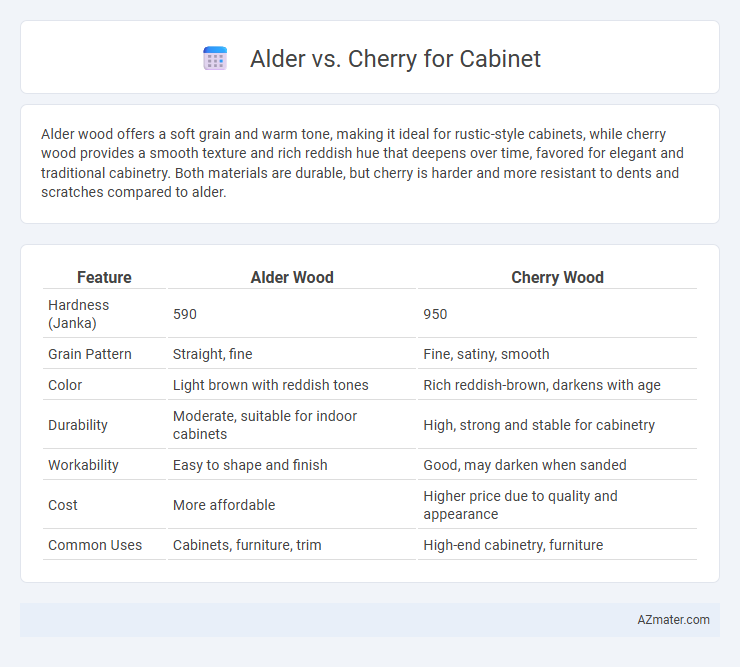Alder wood offers a soft grain and warm tone, making it ideal for rustic-style cabinets, while cherry wood provides a smooth texture and rich reddish hue that deepens over time, favored for elegant and traditional cabinetry. Both materials are durable, but cherry is harder and more resistant to dents and scratches compared to alder.
Table of Comparison
| Feature | Alder Wood | Cherry Wood |
|---|---|---|
| Hardness (Janka) | 590 | 950 |
| Grain Pattern | Straight, fine | Fine, satiny, smooth |
| Color | Light brown with reddish tones | Rich reddish-brown, darkens with age |
| Durability | Moderate, suitable for indoor cabinets | High, strong and stable for cabinetry |
| Workability | Easy to shape and finish | Good, may darken when sanded |
| Cost | More affordable | Higher price due to quality and appearance |
| Common Uses | Cabinets, furniture, trim | High-end cabinetry, furniture |
Introduction to Alder and Cherry Wood
Alder wood, known for its fine grain and light reddish-brown hue, offers a soft texture that is easy to stain and shape, making it a popular choice for affordable cabinetry with a natural look. Cherry wood features a smooth grain and rich reddish-brown color that deepens with age, providing a luxurious and durable option commonly used in high-end cabinetry. Both woods are valued for their workability and aesthetic appeal, but cherry cabinets typically command a higher price due to their hardness and elegant finish.
Key Differences Between Alder and Cherry
Alder wood offers a softer texture and lighter color compared to Cherry, making it ideal for casual or rustic cabinet designs, while Cherry wood is denser and exhibits rich reddish tones that deepen with age, providing a more formal and elegant appearance. Alder is easier to stain and shape due to its lower hardness rating around 590 on the Janka scale, whereas Cherry, with a hardness of about 950, resists dents and scratches better, enhancing durability. The natural grain of Alder tends to be straighter and less pronounced, contrasting with Cherry's smooth, fine grain that often includes distinctive growth rings and subtle color variations.
Appearance and Grain Patterns
Alder wood features a smooth, uniform grain with subtle knots, creating a warm, rustic appearance ideal for traditional and cozy cabinetry designs. Cherry wood boasts a fine, straight grain with rich, reddish undertones that deepen over time, offering an elegant and sophisticated look perfect for high-end cabinetry. The contrast in grain patterns--Alder's soft, muted texture versus Cherry's pronounced, polished finish--makes each wood type distinct in visual appeal and style preference.
Durability and Hardness Comparison
Alder wood is softer with a Janka hardness rating of around 590, making it easier to dent and scratch compared to cherry wood, which has a higher Janka hardness of approximately 950. Cherry cabinets offer superior durability, as their dense grain resists wear and damage over time, ideal for high-traffic kitchen areas. Choosing cherry wood enhances the longevity of cabinetry, while alder remains a budget-friendly option with less resistance to impact and abrasion.
Workability and Machining Properties
Alder wood offers excellent workability due to its softness and uniform texture, making it easy to cut, carve, and shape for detailed cabinetry. Cherry, while slightly harder than alder, machines smoothly and holds intricate details well, providing durability without compromising ease of finishing. Both woods respond well to staining and sanding, but alder's lower density reduces wear on tools, making it preferable for projects requiring extensive machining.
Cost and Availability
Alder wood offers a more cost-effective option for cabinetry compared to cherry, with prices typically 20-30% lower due to its faster growth and wider availability. Cherry is considered a premium hardwood, often commanding higher prices because of its durability, rich color, and limited supply. Both woods are readily available in lumberyards, but alder's quicker replenishment rate makes it more accessible for large-scale or budget-conscious projects.
Staining and Finishing Characteristics
Alder wood offers a smooth, consistent grain that absorbs stains evenly, resulting in a rich, warm finish ideal for rustic or traditional cabinets. Cherry wood features a tighter, finer grain that deepens in color over time, producing a natural patina that enhances finished surfaces with a lustrous, elegant appearance. Staining alder allows for versatile color customization, while cherry typically requires a clear or light finish to preserve its distinctive reddish-brown hue and natural aging process.
Best Uses for Alder Cabinets
Alder cabinets are ideal for rustic, traditional, and transitional kitchen designs due to their fine grain and smooth texture, which accept stains and paints exceptionally well. Their durability makes them perfect for high-traffic areas, while the wood's warm, reddish-brown tones add a cozy, inviting feel. Compared to cherry, alder offers greater affordability and versatility, making it a top choice for custom cabinetry and varied finishes.
Best Uses for Cherry Cabinets
Cherry cabinets are highly prized for their rich, warm tones and smooth grain, making them ideal for formal kitchens and traditional-style interiors where a luxurious, timeless look is desired. Their durability and natural resistance to dings ensure longevity in high-traffic areas, while their ability to darken gracefully over time adds depth and character to the cabinetry. Cherry wood's fine texture also allows for intricate detailing and finishes, perfect for custom, high-end cabinetry projects.
Which Wood is Better for Your Cabinets?
Alder wood offers a smooth grain and warm reddish-brown tones, making it ideal for rustic or traditional cabinet styles, while cherry wood boasts rich, deep colors that darken with age, providing a luxurious and elegant finish. Alder is generally more affordable and easier to work with due to its softer texture, whereas cherry is denser and more durable, enhancing cabinet longevity. Choosing between alder and cherry depends on budget, desired aesthetic, and durability needs, with cherry favored for high-end, long-lasting cabinetry and alder suited for cost-effective, charming designs.

Infographic: Alder vs Cherry for Cabinet
 azmater.com
azmater.com